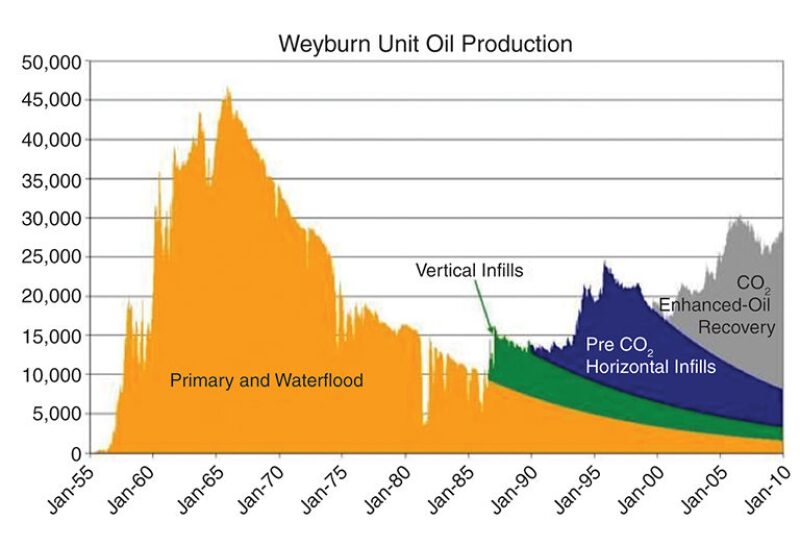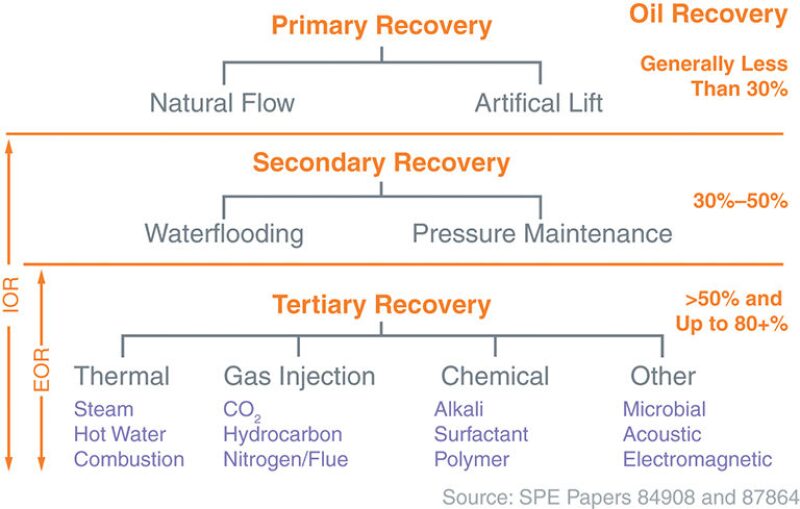As the price of oil reached approximately USD 147 per barrel on 3 July 2008, an increasing number of mature oil fields became attractive for redevelopment. On the fifth anniversary of the highest oil price yet attained TWA asked,“What defines a mature oil field?”
According to Paul Bondor, 2010–11 SPE Distinguished Lecturer, retired from Shell after 35 years of technical and supervisory service, “a mature oil field is an oil field that is considered fully developed. There may be infill opportunities but in general the field-development plan has been executed.
“There may or may not be secondary recovery with gas or water injection. But if there are no additional wells to be drilled, you are doing a decent job of reservoir management and your production has peaked and is on decline. For example, with a strong and active aquifer you may never put water in the ground but you will still get eventual high water cut.
“To me, a mature oil field is one where you have development in place, and the field has peaked and is on decline.”
Jonathan Williams, geoscience team leader at BP, said, “You have really got to think of it in terms of how much ultimate recovery potential you have already achieved and where are you in that production profile. Once you come off plateau, that’s when you start calling yourself mature.
“When we look at oil fields, especially at onshore locations, they have 30- to 60- to 100-year lives. Until you reach the technical limit of ultimate recovery, there are opportunities; they may not be economic but there are always opportunities. So a mature oil field is one that has come off plateau, that then has oil processing capacity where finding the right technology can unleash those barrels into the facilities.
“I look at oil profiles almost the other way around. I’m always thinking about what is the capacity. That gap between what you are producing and what is the capacity—and therein lies the opportunity. If you flipped it on its head and did not look at water-handling capacity or gas-handling capacity and you just look at oil-processing capacity versus oil throughput, in most fields you have a whole field’s worth of underutilized capacity.”
R. Keith MacLeod, president of Sproule International Ltd and SPE Director, Canada, commented, “Mature fields are very important, as recent studies estimate that hydrocarbon production from these fields will account for more than one-half of the global energy mix for at least the next 20 years.
“Since most of the world’s oil basins have been explored and large discoveries are occurring less frequently, it will be critical for companies to improve recovery from mature fields. The great asset of mature fields is the large volumes of hydrocarbons in place that have been identified through drilling, testing, historical production, and pressure data. This generally provides very low risk related to encountering hydrocarbons while drilling.
“Mature fields also benefit from existing wellbores, surface infrastructure, and government approvals that can provide timely redevelopment and improved economics on incremental recovery projects. Mature fields offer excellent opportunities to experiment with new reservoir-management techniques or technologies related to geoscience, production optimization, enhanced-recovery schemes, drilling, and facilities with the objective of enhancing production levels or reducing field decline rates.”
Technology, Trial and Error
Getting to oil that once seemed unrecoverable is one of the energy industry’s tasks. Technological advances should allow hydrocarbon production keep up with world energy demand for some decades to come.

An example of where evolving technology played a key role is the Weyburn oilfield unit operated by Cenovus Energy in western Canada (Fig.1). The Weyburn oil field began its decline in the late 1960s, making it “mature” at that point. However, redevelopment opportunities from the late 1980s until the present have actually increased production. Infill drilling both vertical and horizontal wells has allowed for increased reservoir exposure and decreased well spacing, offering better economics. In 2000, the Weyburn oil field became a carbon sequestration project, whereby CO2 was injected into the reservoir for the purpose of enhanced oil recovery (Fig. 2) and long-term CO2 storage. Today, the oil field continues to operate, with CO2 being delivered by pipeline from North Dakota.

Another example is the Forties field in the North Sea, which was acquired by Apache in 2003. Apache’s engineers and geoscientists have increased the value of the field by adding reserves and production. A successful drilling program was initiated by utilizing 4D seismic that identified areas of the field that have not been sufficiently drained, and by reducing costs through utilizing new drilling equipment, such as a modern jack-up rig. Another advancement features the ring main project, which allowed electricity to be generated using natural gas from the field instead of purchased fuel oil. The reward is large: Each additional 1% recovery of the 5 billion bbl of original oil in place is the equivalent of a 45- to 50-million-bbl discovery. This progressive work continues today.
What to Think About When Revitalizing Mature Oil Fields
MacLeod believes that revitalizing mature oil fields can be started with a few steps. The first step, he said, should be to prepare an integrated reservoir study to identify the hydrocarbons initially in place, in all zones, and to develop an understanding of the remaining hydrocarbons in each zone based on the current field-development plan.
The second step, he continued, should be to review development strategies and technologies used by other companies elsewhere in the world.
Utilizing resources such as SPE’s OnePetro and other SPE resources as well as those of other technical societies can help engineers and geoscientists better understand what’s out there, said MacLeod. Management will give more serious weight to your recommendations and request for funding, he said further, if they are supported by successful outcomes in analogous fields.
The third step, according to MacLeod, is to test the strategies and technologies using a reservoir simulation model and assess their potential economics. It may be necessary to carry out a field pilot project to demonstrate technical and economic feasibility. Ultimately, economics will determine whether a mature field is revitalized.
There are several key factors in developing mature oil fields—some obvious and others less obvious. Reservoir conditions, oil prices, development costs, surrounding pipeline infrastructure, and regulatory frameworks tend to be the more obvious factors.
However one less obvious factor is a government’s taxation schemes. An example of this would be in the UK. Tax breaks for the oil exploration and extraction industry introduced by the UK government during 2012 have had a significant effect on the UK North Sea. For example, many small- to mid-cap operators have purchased mature oil fields as optimization projects. Guaranteeing brownfield tax allowances to operate mature oil fields in the North Sea helps extend the life of fields, thus helping to make the most out of potential energy resources.
Advice for Young Professionals
According to Williams, when first approaching a mature oil field, it is necessary to understand and apply the engineering principles learned while in college. “Know from first engineering principles what ‘good’ looks like,” he said. For a reservoir engineer this would mean looking at decline analysis from existing wells and material balance. For a geologist or petrophysicist, this would mean understanding and calculating the hydrocarbons-in-place; then comparing this with the recovery potential of the existing wells in that fault block would be key to understanding the total field potential. Williams emphasized not to be afraid to challenge the existing interpretation and use the full suite of production history to redefine what is possible in a mature field.
There is usually new surveillance data available that was not there when previous decisions were made. Bondor stressed learning from the past and always seeking out the best options that can be supported by available data. He likens this approach to operating a field trial. Having awareness that different individuals have different drivers based on their experience is key, he said. Initial pilots, such as to prove a new technology, may be done on the worst well in the field because operations staff do not want to negatively impact their production targets. When pursuing technology pilots, a new well should be drilled “so that there are no inherited problems,” said Bondor.

|

|

